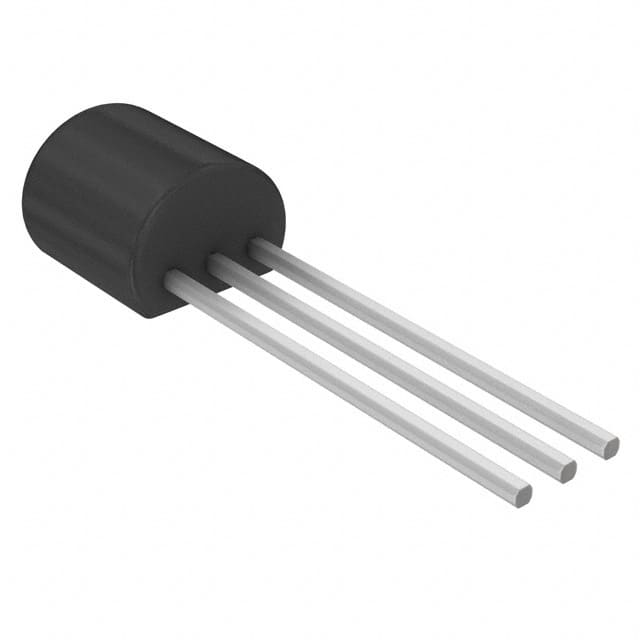PN3565 Transistor
Product Overview
The PN3565 transistor is a versatile electronic component that belongs to the category of small-signal transistors. It is commonly used in amplification and switching circuits due to its high gain and low noise characteristics. The transistor comes in a variety of packages, including TO-92, SOT-23, and SOT-223, making it suitable for various applications. Its essence lies in its ability to control the flow of current in electronic circuits, thereby enabling precise signal amplification and switching operations.
Basic Information
- Category: Small-signal transistor
- Use: Amplification and switching circuits
- Characteristics: High gain, low noise
- Package: TO-92, SOT-23, SOT-223
- Packaging/Quantity: Typically available in reels or tubes containing multiple units
Specifications
- Maximum Collector-Base Voltage (Vcb): 60V
- Maximum Collector-Emitter Voltage (Vce): 40V
- Maximum Emitter-Base Voltage (Veb): 6V
- Continuous Collector Current (Ic): 200mA
- Power Dissipation (Pd): 625mW
- Transition Frequency (ft): 250MHz
Detailed Pin Configuration
The PN3565 transistor typically consists of three pins: the collector (C), base (B), and emitter (E). In a TO-92 package, the pin configuration is as follows: - Pin 1 (Collector): Connected to the positive terminal of the circuit - Pin 2 (Base): Input terminal for controlling the transistor's conductivity - Pin 3 (Emitter): Connected to the negative terminal of the circuit
Functional Features
- High gain: The PN3565 transistor offers high current gain, making it suitable for amplification purposes.
- Low noise: It exhibits low noise characteristics, ensuring minimal interference with the input signal.
- Versatile packaging: Available in various packages, allowing flexibility in circuit design and implementation.
Advantages and Disadvantages
Advantages
- High gain and low noise characteristics make it ideal for signal amplification in audio and radio frequency applications.
- Versatile packaging options enable integration into compact electronic devices.
Disadvantages
- Limited power handling capability compared to power transistors, restricting its use in high-power applications.
Working Principles
The PN3565 transistor operates based on the principles of semiconductor physics. When a small current is applied to the base terminal, it controls the larger current flowing between the collector and emitter terminals. This property allows the transistor to amplify weak signals and act as a switch in electronic circuits.
Detailed Application Field Plans
The PN3565 transistor finds extensive application in the following fields: 1. Audio Amplification: Used in audio amplifiers and preamplifier stages due to its high gain and low noise characteristics. 2. Radio Frequency Circuits: Employed in RF amplifiers and oscillators for signal processing and transmission. 3. Switching Circuits: Utilized in digital logic circuits and signal switching applications due to its fast switching speed.
Detailed and Complete Alternative Models
Several alternative models to the PN3565 transistor include: - 2N3904 - BC547 - 2N2222 - MPSA18
These alternatives offer similar small-signal amplification and switching capabilities, providing flexibility in circuit design and component selection.
In conclusion, the PN3565 transistor serves as a fundamental building block in electronic circuits, offering high gain, low noise, and versatile packaging options. Its application spans across audio amplification, radio frequency circuits, and digital switching, making it an indispensable component in modern electronics.
Word Count: 511
Lista 10 Vanliga frågor och svar relaterade till tillämpningen av PN3565 i tekniska lösningar
What is PN3565?
- PN3565 is a general-purpose NPN transistor commonly used in electronic circuits for amplification and switching purposes.
What are the typical applications of PN3565?
- PN3565 can be used in various technical solutions such as audio amplifiers, signal amplification, voltage regulation, and oscillator circuits.
What are the key electrical characteristics of PN3565?
- The key electrical characteristics of PN3565 include its maximum collector current (IC), maximum power dissipation (Pd), and DC current gain (hFE).
How do I determine the pin configuration of PN3565?
- The pin configuration of PN3565 is typically available in its datasheet, which shows the base, emitter, and collector terminals along with their corresponding pin numbers.
Can PN3565 be used for low-power switching applications?
- Yes, PN3565 can be used for low-power switching applications due to its ability to handle moderate currents and voltages.
What are the recommended operating conditions for PN3565?
- The recommended operating conditions for PN3565 include a specified range of collector current, collector-emitter voltage, and operating temperature.
How can PN3565 be utilized in audio amplifier circuits?
- PN3565 can be used in audio amplifier circuits to amplify weak audio signals from sources such as microphones or musical instruments.
Is PN3565 suitable for use in voltage regulator designs?
- Yes, PN3565 can be utilized in voltage regulator designs to stabilize and regulate the output voltage in various electronic devices.
What are the typical performance limitations of PN3565?
- Some typical performance limitations of PN3565 include its maximum operating frequency, saturation voltage, and power dissipation constraints.
Are there any common alternative transistors to PN3565?
- Yes, common alternative transistors to PN3565 include 2N3904, BC547, and 2N2222, which have similar characteristics and can be used as substitutes in many applications.


